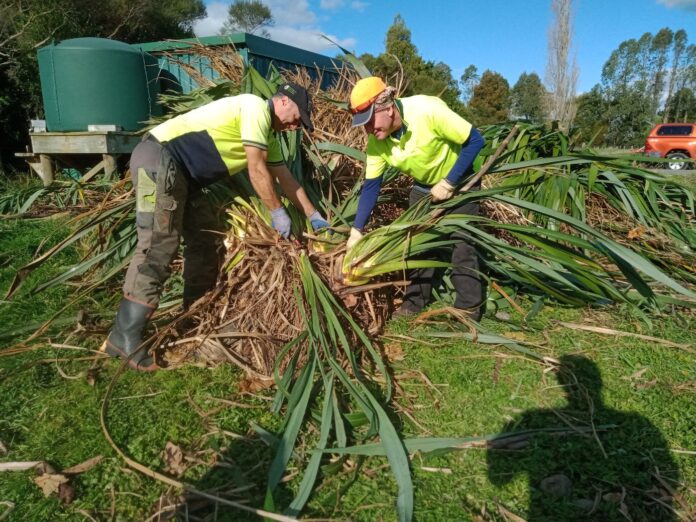Source: Department of Conservation
When Kaipaki School contacted the Waikato DOC Office with an offer to donate some harakeke plants from its school grounds, Dion Patterson, Living Water Site Lead for the Waikato Peat Lakes, saw an opportunity that would benefit the community.
What does it mean to have vision?
The first definition in the Oxford Dictionary describes vision as “the faculty or state of being able to see”. It’s our physical ability to perceive through sight, our ability to see the material things in front of us: the places we’re in, the things we can hold and touch, the people we’re with.
But we also know vision is more than that.
Kaipaki School is a small rural school along Kaipaki Road in the Waikato. In May 2021 the Kaipaki School Deputy Principal, Nicky Pearse, emailed the Department of Conservation’s Waikato District Office. The school was having a working bee to re-landscape its grounds and there were several very large flaxes in front of a school building. They were old, overgrown, and had served their purpose.
“The harakeke were no longer needed and had outgrown the changing landscape of the school grounds,” says Dion Patterson, Living Water Site Lead for the Waikato Peat Lakes. “But the school didn’t want to rip them out and discard the plants; they wanted to repurpose the plants and find a new space for them.”
Vision also means being able to see beyond the spaces we’re in.
“Nicky wanted to see the plants taken and used by community groups for lake, wetland or waterway restoration,” says Dion.
Opportunities can present themselves in many ways, in many disguises, and our experiences train our eyes to see them.
“The Living Water team have experience with re-purposing harakeke and we immediately understood what could be possible,” Dion says
Five days later, Living Water called on a team of tree removal specialists who arrived at the school afterhours with a small digger to uplift 10 -15 large flaxes and load them onto trailers. The plants were taken to Lake Rotomanuka in Ohaupo for preparation. The next day another team of tree specialists arrived at the lake and went to work on the flaxes. Over the next few days, they prepared 500 – 600 flax cuttings.
Vision also means being able to see the possibilities in the things we can hold and touch.
Living Water had 600 flax cuttings to find new spaces for. The team set to work, getting in touch with its thriving community network.
“We reached out to Mark Walker from the Mangaotama Stream and Wetland Restoration Trust,” says Dion.
“He saw the opportunity. The group is leading great restoration work in the catchment and there was a place there for cuttings in the restoration this waterway.”
The Mangaotama Stream flows east from Ohaupo into the Waipa River and the Mangaotama wetland, where the group does most of its work, is at the lower end of the catchment.
“Mangaotama Stream and Wetland Restoration Trust then shared some of the cuttings with its neighbouring community group, the Mangahia Gully Care Group to help support its restoration project.” says Dion.
Fifty cuttings were also used by local volunteer Alasdair Nichol to fill gaps in the lake margin at Lake Rotomanuka; and the harakeke leaves trimmed from the plants when making the cuttings were offered to Te Wananga O Aotearoa in Te Awamutu for weaving tuition.
“We were blown away by how it all worked out,” says Dion. “It illustrated how important it is for us stay connected to our communities when we’re trying to achieve ambitious conservation goals. It reminds us good things happen when we work together and learn to see the opportunities around us.”
So what does it mean to have vision? The second definition from the Oxford Dictionary describes vision as “the ability to think about or plan the future with imagination and wisdom”. It’s our ability to understand the people we’re with, the communities we’re in, and share a common goal.It’s our mental, emotional, spiritual ability to perceive through another kind of sight, where we see the old, the overgrown, the served-its-purpose, and then we look again and see something else entirely different: potential.
Our 10-year partnership with Fonterra supports work to enable farming and freshwater to thrive together.
Find out more about the Living Water partnership on our website.



